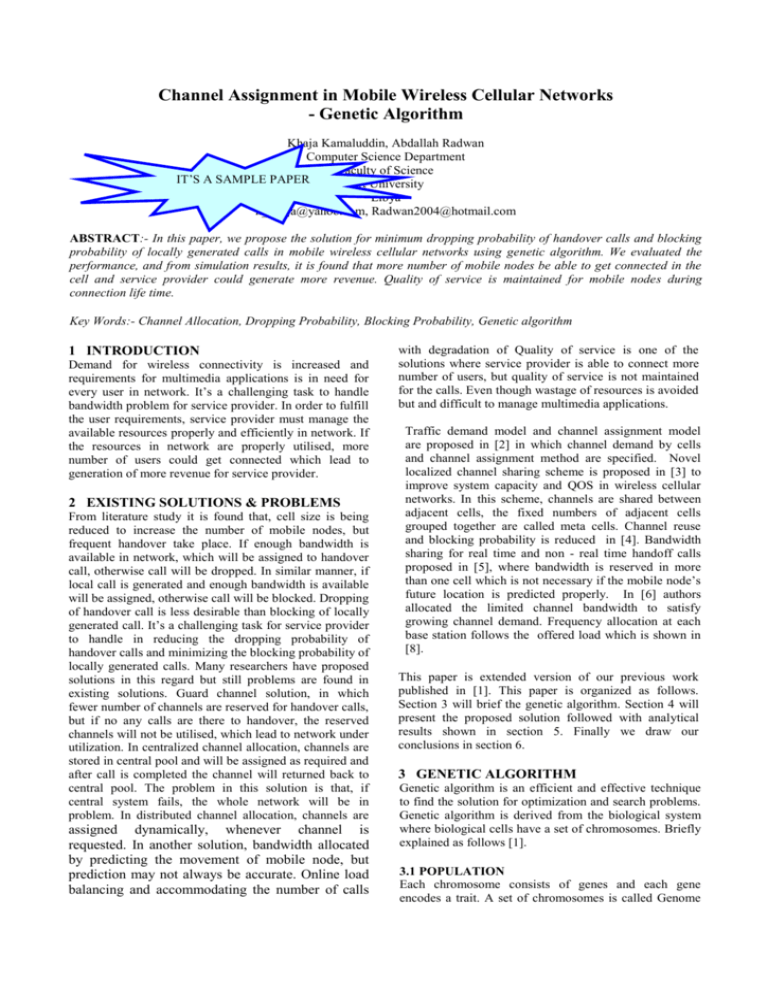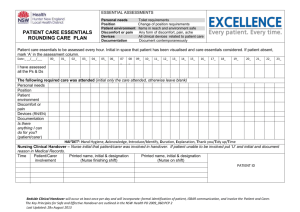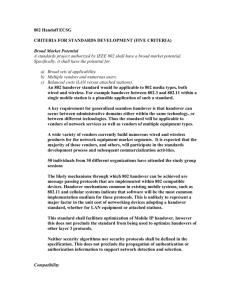Template for Final Camera Ready Version
advertisement

Channel Assignment in Mobile Wireless Cellular Networks
- Genetic Algorithm
Khaja Kamaluddin, Abdallah Radwan
Computer Science Department
Faculty of Science
IT’S A SAMPLE PAPER
Sirt University
Libya
k_khaja@yahoo.com, Radwan2004@hotmail.com
ABSTRACT:- In this paper, we propose the solution for minimum dropping probability of handover calls and blocking
probability of locally generated calls in mobile wireless cellular networks using genetic algorithm. We evaluated the
performance, and from simulation results, it is found that more number of mobile nodes be able to get connected in the
cell and service provider could generate more revenue. Quality of service is maintained for mobile nodes during
connection life time.
Key Words:- Channel Allocation, Dropping Probability, Blocking Probability, Genetic algorithm
1 INTRODUCTION
Demand for wireless connectivity is increased and
requirements for multimedia applications is in need for
every user in network. It’s a challenging task to handle
bandwidth problem for service provider. In order to fulfill
the user requirements, service provider must manage the
available resources properly and efficiently in network. If
the resources in network are properly utilised, more
number of users could get connected which lead to
generation of more revenue for service provider.
2 EXISTING SOLUTIONS & PROBLEMS
From literature study it is found that, cell size is being
reduced to increase the number of mobile nodes, but
frequent handover take place. If enough bandwidth is
available in network, which will be assigned to handover
call, otherwise call will be dropped. In similar manner, if
local call is generated and enough bandwidth is available
will be assigned, otherwise call will be blocked. Dropping
of handover call is less desirable than blocking of locally
generated call. It’s a challenging task for service provider
to handle in reducing the dropping probability of
handover calls and minimizing the blocking probability of
locally generated calls. Many researchers have proposed
solutions in this regard but still problems are found in
existing solutions. Guard channel solution, in which
fewer number of channels are reserved for handover calls,
but if no any calls are there to handover, the reserved
channels will not be utilised, which lead to network under
utilization. In centralized channel allocation, channels are
stored in central pool and will be assigned as required and
after call is completed the channel will returned back to
central pool. The problem in this solution is that, if
central system fails, the whole network will be in
problem. In distributed channel allocation, channels are
assigned dynamically, whenever channel is
requested. In another solution, bandwidth allocated
by predicting the movement of mobile node, but
prediction may not always be accurate. Online load
balancing and accommodating the number of calls
with degradation of Quality of service is one of the
solutions where service provider is able to connect more
number of users, but quality of service is not maintained
for the calls. Even though wastage of resources is avoided
but and difficult to manage multimedia applications.
Traffic demand model and channel assignment model
are proposed in [2] in which channel demand by cells
and channel assignment method are specified. Novel
localized channel sharing scheme is proposed in [3] to
improve system capacity and QOS in wireless cellular
networks. In this scheme, channels are shared between
adjacent cells, the fixed numbers of adjacent cells
grouped together are called meta cells. Channel reuse
and blocking probability is reduced in [4]. Bandwidth
sharing for real time and non - real time handoff calls
proposed in [5], where bandwidth is reserved in more
than one cell which is not necessary if the mobile node’s
future location is predicted properly. In [6] authors
allocated the limited channel bandwidth to satisfy
growing channel demand. Frequency allocation at each
base station follows the offered load which is shown in
[8].
This paper is extended version of our previous work
published in [1]. This paper is organized as follows.
Section 3 will brief the genetic algorithm. Section 4 will
present the proposed solution followed with analytical
results shown in section 5. Finally we draw our
conclusions in section 6.
3 GENETIC ALGORITHM
Genetic algorithm is an efficient and effective technique
to find the solution for optimization and search problems.
Genetic algorithm is derived from the biological system
where biological cells have a set of chromosomes. Briefly
explained as follows [1].
3.1 POPULATION
Each chromosome consists of genes and each gene
encodes a trait. A set of chromosomes is called Genome
and a particular set of genes in genome is called genotype.
Genetic algorithm starts with generating sets of
chromosomes called population.
3.2 FITNESS FUNCTION
Fitness values will be assigned to each chromosome.
Better fitness will be the bigger chances of selection.
Fitness function for each chromosome is evaluated
according to the respective fitness value.
3.3 SELECTION
According to fitness value, Chromosomes will be
selected for further process of recombination.
3.4 CROSSOVER
After selection, Crossover process takes place in order
to produce offspring (new population). Crossover will
be done by following appropriate method. In case, if
crossover does not take place, the same copy of
original chromosome will enter into new population.
handover calls and blocking probability of local calls.
Sample space Ω = All randomly generated mobile nodes
= {m1, m2, m3,……}
Ω = {m│m ε Ω}
Set A is a group of Handover calls
Set B is a group of Local calls
A ⊂ Ω and B ⊂ Ω
A ε Ω and B ε Ω
Ω = {A1,A2,A3,……, An, B1, B2,
B3……..Bn} ----------------------(1)
A = {A1,A2,A3,……An} -----------------(2)
B = {B1,B2,B3,….Bn} --------------------(3)
Minimum channel capacity fixed is 0.1 unit for
calls.
Fitness score table shows the bandwidth
utilization in past.
Details
Fully utilized
Partially
utilized
Not utilized
Bottlenecked
3.5 MUTATION
After crossover, newly created offspring can be
mutated and placed in new population.
3.6 ELITISM
In order to prevent the loss of better
chromosomes, Elitism process is used, in which
the better chromosomes will be just copied into
new population.
Population
Fitness Function
Fitness Score
3
2
1
0
Table1. Fitness (Bandwidth Utilization)
5
ANALYTICAL EVALUATION
Performance is evaluated based upon fitness score
calculated for handover calls. Simulation results
shown in figure2, about the dropping probability of
handover calls is maintained minimum. In figure3,
local calls generated in cell are added with low fitness
handover calls. It is found that from simulation results,
blocking probability is to the acceptance level.
Dropping Probability
35
0.40
30
0.35
25
0.30
0.25
20
0.20
15
0.15
10
TC
PD
0.10
5
0.05
0
0.00
t1
t2
t3
t4
t5
t6
t7
t8
t
t19
0
t1
t11
2
t1
t13
4
t1
5
t1
t16
7
t1
t18
9
t2
0
Mutation
Pd
Crossover
Calls
Selection
Time
New Population
Figure1. Genetic Algorithm
4
PROPOSED SOLUTION
In [1], Bandwidth is allocated for handover calls and in
this proposed solution, we extended our work in
bandwidth allocation to locally generated calls along with
handover calls and evaluated the dropping probability of
Figure2. Dropping probability
From our simulation results, we found that using
genetic algorithm, more number of handover calls
could get connected along with reasonable number of
local calls.
ISBN: 0-7803-8783-X
0.80
0.70
0.60
0.50
0.40
0.30
0.20
0.10
0.00
Pb
16
14
12
10
8
6
4
2
0
TLC
Pb
[ 7] Ines Ben Hamida, Lila Boukhatem, Mazen Neifer
and Sami Touati, “Efficient resource reservation
with optimal channel requests classification in
cellular systems”, Personal, Indoor and Mobile
Radio Communications, 2005. PIMRC 2005. IEEE
16th International Symposium, Volume: 3, On
page(s): 2072- 2076, ISBN: 978-3-8007-29
t1
t2
t3
t4
t5
t6
t7
t8
t
t19
0
t1
t11
t12
t13
t14
t15
t16
7
t1
t18
t29
0
Local Calls
Blocking Probability
Time
Figure3. Blocking probability
With this solution more number of user could get
connected to network which leads service provider to
generate more revenue.
6 CONCLUSION
In this paper, channel allocation using genetic algorithm
is proposed, in which dropping probability of handover
calls and blocking probability of local calls is evaluated.
Our simulation results show that, dropping probability is
minimum and blocking probability obtained is to
acceptance level. Quality of service could be maintained
with this solution. With this solution more number of
calls could get connected which lead to generate more
revenue for service provider.
REFERENCES:
[ 1] Khaja Kamaluddin, Abdalla Radwan, Bandwidth
Allocation for Handover calls in Mobile Wireless
Cellular Networks – Genetic Algorithm Approach,
Proceedings of ACIT2010, Dec 14-16 2010,
Garyounis University, Libya.
[ 2] Sa Liu, Karen Daniels and Kavitha Chandra,
“Channel Assignment for
Time Varying
Demand”, Proceedings of GLOBECOM’01, p35633567, 2001.
[ 3] Junyi Li, Ness B. Shroff and Edwin K.P Chong, “A
new localized channel sharing
scheme for
cellular
networks”,
ACM/Baltzer
Wireless
Networks, 5(6):503--517, 1999.
[ 4] Murtaza Zafer and Eytan Modiano, “ Blocking
Probability and Channel Assignment
in Wireless
Networks”, IEEE Transactions On Wireless
Communications, Vol. 5, No. 4, April 2006
[ 5] Qian Huang, Sammy Chan, King-Tim Ko,
“Dynamic Bandwidth Sharing for Handoff Traffic
in Multimedia mobile Cellular Networks”,
Electronic Letters, Volume 39, Issue 10, 15 May
2003 Page(s): 801 - 802
[ 6] Graham Kendall and Mazlan Mohamad, “Channel
Assignment in Cellular Communication using a
Great Deluge
Hyper-Heuristic”, Volume: 2, On
page(s): 769- 773,
Vol.2, ISSN: 1531-2216
[ 8] Marina Papatriantafilou, David Rutter and Philippas
Tsigas, “Distributed frequency
allocation
algorithms for cellular networks: Trade-offs
and Tuning strategies”, Proceedings of the 13th
International Conference on Parallel and Distributed
Computing and Systems (PDCS'01), pages. 339344.
[ 9] Mireille Palpant, Cristian Oliva, Christian
Artigues1, Philippe Michelon, Mohamed Didi
Biha, “Models and methods for frequency allocation
with
cumulative interference constraints”,
submitted to
the International Transactions in
Operational Research, special issue IFORS 2005.








